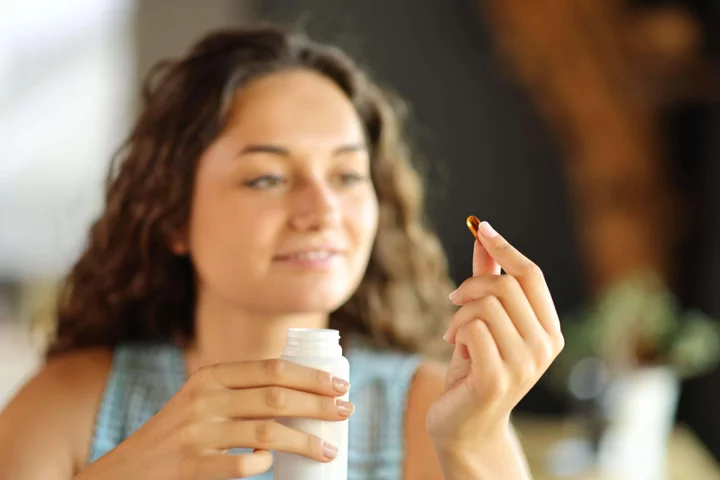
These are the cheapest school uniforms on the high street – according to Which?
Sainsbury’s is the cheapest place to buy school uniforms while Next is the most expensive at more than double the price, according to research. Consumer group Which? analysed the costs of a selection of essential school uniform items for nine-year-olds at eight supermarkets and clothing retailers. The items included two each of pinafore dresses, polo shirts, skirts, sweatshirts, boys’ trousers and girls’ trousers. Household budgets have been battered by an unrelenting cost of living crisis, but our latest research shows some retailers will help your money go further than others Ele Clark, Which? retail editor The group said its research showed that at a time when household budgets are being “battered by an unrelenting cost-of-living crisis”, money will go further at some retailers than others. Which? said Tu Clothing at Sainsbury’s was the cheapest, costing a total of £47. At Next, the same selection cost £102, the group said, although it noted that due to some of the items being sold individually rather than in multipacks, it had to double the price of a single item to allow for comparison. Second-cheapest was Morrisons, costing £48.95, followed by George clothing at Asda, F&F Clothing at Tesco, Matalan, Marks & Spencer and John Lewis’s Anyday range, Which? said. The consumer group said Morrisons and Tesco prices were shared directly with Which? on July 26, while they checked the prices of items from the rest of the retailers on August 9. The group said its analysis focused only on the prices of items, rather than any differences in the quality, comfort or durability. Aldi and Lidl were also cited as selling cheap uniforms, but were not included in the Which? analysis as the group said the supermarkets tend to have “special buy” deals which sell out quickly and are generally not restocked. Ele Clark, Which? retail editor, said: “School uniforms don’t come cheap – especially if you have to buy them for more than one child. Household budgets have been battered by an unrelenting cost-of-living crisis, but our latest research shows some retailers will help your money go further than others. “Parents and guardians can also save money by buying second-hand, opting for multipacks, choosing longer-lasting options such as trousers with a hem that can be let down, and of course, keeping an eye out for special offers.” In June, a charity warned that parents were still having to spend “exorbitant amounts” on school uniform despite changes introduced last year aimed at keeping costs down. The Children’s Society said its research suggested parents and carers of secondary school children were paying on average £422 per year on uniform, and around £287 for primary school children. It said the high costs were partly due to the requirement from some schools for branded items which have to be bought from specialist shops rather than supermarkets or high-street chains. A Department for Education spokesperson said at the time that it expected schools in England to comply with its uniforms guidance – which requires schools to keep branded uniform items to a minimum and allow more high-street options – by September.
2023-08-17 13:56

A Mediterranean lifestyle helps you live longer – study
Scientists have found more evidence to suggest that leading a Mediterranean lifestyle could be key to living a longer and healthier life. People who follow a Med lifestyle – including making time for socialising; resting; physical activity and eating a diet rich in fruits, vegetables, and whole grains with low sugar and salt intake – are less likely to die prematurely or die from cancer. And those who get plenty of rest, exercise and make time to socialise with friends are less likely to die as a result of a heart attack or stroke. The new study examined data on 110,799 adults taking part in the UK Biobank study. This study suggests that it’s possible for non-Mediterranean populations to adopt the Mediterranean diet using locally available products and to adopt the overall Mediterranean lifestyle within their own cultural contexts Mercedes Sotos Prieto People aged 45 to 70 from England, Wales and Scotland provided detailed information about their diet and lifestyle habits. The researchers, led by academics from La Universidad Autonoma de Madrid in Spain and Harvard TH Chan School of Public Health in the US, examined information ON Mediterranean food consumption; Mediterranean dietary habits – such as limiting salt and consuming healthy drinks – and lifestyle habits including taking regular naps, exercising, and spending time with friends. Higher total scores in these categories indicated a higher adherence to the Mediterranean lifestyle, the authors said. People involved in the study were tracked for nine years. Some 4,247 people died including 2,401 from cancer and 731 from cardiovascular disease, which includes heart attacks and strokes. Researchers found that people who followed a Mediterranean lifestyle were 29% less likely to die compared to their peers who did not follow this lifestyle. They were also 28% less likely to die from cancer, according to the study, which has been published in the journal Mayo Clinic Proceedings. And people who got plenty of rest and exercise, while also making time to socialise with friends, were also less likely to die from cardiovascular disease. “This study suggests that it’s possible for non-Mediterranean populations to adopt the Mediterranean diet using locally available products and to adopt the overall Mediterranean lifestyle within their own cultural contexts,” said lead author Mercedes Sotos Prieto, from La Universidad Autonoma de Madrid and Harvard Chan School. “We’re seeing the transferability of the lifestyle and its positive effects on health.” Read More Charity boss speaks out over ‘traumatic’ encounter with royal aide Ukraine war’s heaviest fight rages in east - follow live These are the cheapest school uniforms on the high street – according to Which? Half of anxiety and depression cases in new and expectant mums are missed: 7 signs a new mum needs help This Morning’s Dr Zoe Williams: Why gut health could be more important than you think this summer
2023-08-17 13:54

The Lost Library of Herculaneum: Unravelling the Scrolls That Mount Vesuvius Almost Destroyed
Historians were struck by the tantalizing possibility that this library might contain missing works of some of history’s greatest writers—works thought to have been lost forever.
2023-08-17 05:23

Michelle Obama says she had the same thing for breakfast each day ‘for most of her life’
Michelle Obama has revealed that her palate is a little more straightforward than some may assume from a former first lady. Speaking on the first episode of Your Mama’s Kitchen, a podcast hosted by journalist Michele Norris and co-produced by the Obamas’ media company, Higher Ground, Michelle revealed she never really enjoyed eating breakfast. “I was kind of a picky eater,” she said. “I didn’t like any breakfast-anything. And my brother, who ate breakfast all the time, thought I was crazy.” Michelle continued: “We had big breakfasts because my brother, he was a growing athlete. So it was everything — cereal followed by scrambled or fried eggs followed by lots of toast and bacon and link sausage. So breakfast was big.” As a result, she explained that “everybody else in the whole household, on the whole planet, loved breakfast food except for [me] ... I despised breakfast.” Michelle revealed that she became “really stubborn” over her breakfast and decided to choose a different meal. “[I ate] peanut butter and jelly every morning until I went to college,” she said. “That was all I really liked. It was sort of a compromise that I made with my mother because it’s got peanuts, that’s protein, a little bit of oil. “Nothing’s wrong with bread if we’re having toast, why can’t I have it in a sandwich form and jelly? Everybody was having jelly on their toast.” She added that this would form her breakfast “every morning for most of [her] life”. However, nowadays, she is a fan of more wide-ranging breakfast foods. “I’m big into all of it now. Give me eggs benedict. Any eggs, any way,” she added. The admission comes after Michelle reflected on former US President Donald Trump’s Inauguration Day and revealed why she was sobbing after it. During the first episode of Michelle Obama: The Light Podcast, she explained why Trump’s Inauguration Day in 2017 was “so emotional”, as she, Barack, and their daughters, Malia, now 24, and Sasha, now 21, were officially moving out of their house. “We were leaving the home we had been in for eight years, the only home our kids really knew,” she explained. “They remembered Chicago but they had spent more time in the White House than anywhere, so we were saying goodbye to the staff and all the people who helped to raise them.” Read More Barack Obama’s message to people of Hawaii after deadly wildfires Obama’s love letters from 1982 resurface: ‘I make love to men daily, but in the imagination’ Billy Porter says he is ‘back on the market’ after filing for divorce Do it for the Gram: Speedy but spectacular goat’s cheese linguine How to pimp up your instant ramen (and save money) Money-saving chilli con carne that absolutely slaps with flavour
2023-08-16 22:24

Half of anxiety and depression cases in new and expectant mums are missed: 7 signs a new mum needs help
Half of all anxiety and depression cases among new and expectant mothers are going undiagnosed, according to a new report. Although 10-20% of women develop mental health problems, which can include anxiety and depression, during pregnancy or within the first year after having a baby, 50% of cases are being missed – despite contact with professionals, the report by the Royal College of Midwives (RCM) found. The report suggested that mental health needs are still secondary to physical health during pregnancy, and has called for a boost in midwife numbers to help spot more cases of mental ill health. Amanda Mansfield, professional advisor to the RCM and one of the lead authors of the report, said the 20% of new or expectant mothers who have mental health issues will experience a range of symptoms. “Often the ‘baby blues’ is normalised because it’s something lots of people get, and women are told, ‘You’ll be fine’,” Mansfield told PA Media. “That can contribute to the fact that significant numbers of women downplay their symptoms – in some reports, up to 70% of women don’t feel able to disclose how they feel, they may feel judged. “Some women feel it may affect their ability to mother, or they may be concerned their baby may be taken away.” Mansfield added that some women may feel unable to share their symptoms with a health professional, because they’re worried about how they’re going to be perceived. “But it really is ok to not be ok, rather than women playing down and diluting their feelings,” she added. It’s a good idea for everyone to be aware of mental health risks during pregnancy and beyond. Here are seven signs that somebody might need mental health support, and how to talk about it… 1. DepressionPregnant women or new mums may feel low, unhappy and tearful for much or all of the time. Mansfield said: “It’s looking for the variation in normal patterns of behaviour. Family and friends should ask, in a very compassionate, non-judgmental way, how the woman’s feeling.” If friends and family don’t feel confident about having such conversations, they should encourage the woman to talk to her health professional, Mansfield added. 2. Anxiety Feelings of anxiety can manifest in many ways, and physical symptoms can include a racing pulse, breathlessness and sweating. But whether there are physical symptoms or not, it’s vital for women to talk about how they’re feeling, said Mansfield. “A woman may say she feels particularly anxious about the birth, or relatives coming over, or the in-laws, and having the space to talk about it is really important, to share the anxiety with a midwife that she has a relationship with.” If these anxious feelings don’t improve over time, Mansfield said they can be referred to a specialist midwife who’s an expert in perinatal mental health, and who may be able to offer additional interventions and support. 3. Altered sleep patterns All new parents will of course find their sleep is affected, but if there is also an underlying mental health issue going on, exhausted women may find it even hard to fall or stay asleep. “Women may have significantly disrupted sleep patterns, but we often normalise that with later pregnancy and new parents having difficulty sleeping,” Mansfield pointed out. “It’s really important that if you’re having problems sleeping, and you may be unable to settle and find your mood is a lot lower, you talk to your health professional about that.” 4. Appetite changes “Some people do find their appetite is affected,” said Mansfield. This may mean women lose their appetite and forget to eat or, conversely, comfort eat and possibly put weight on. 5. Difficulty concentrating It’s common for women to describe having ‘brain fog’ when they’re pregnant or have just had a baby, but sometimes an inability to concentrate can be a sign of a deeper problem. Mansfield explained: “A woman’s ability to concentrate can be markedly affected, and we often downplay that – it can be a subtlety that we ally with having a baby or being pregnant, but these can be really important signs and symptoms to share with your health professional, as they may suggest there’s something that needs exploring further.” 6. Obsessive compulsive behaviour Starting to behave obsessively or compulsively, or symptoms of any pre-existing obsessive compulsive disorder (OCD) getting worse, can be linked to perinatal mental ill health too. “Some women may be excessively tidying, for example, or be fixated on something and they may become more anxious,” said Mansfield. “Very commonly, obsessive compulsive disorder may become worsened. Certainly if someone does have compulsive disorders, it’s important not to put them to one side, but share them with your midwife. Picking it up early is so important.” 7. Unusual thoughts Of course, new parents will have lots of new things to think about – but when those thoughts are perhaps a little unusual, it’s worth talking to family, friends and your midwife or health visitor about them. Mansfield said: “Women may present with different thoughts they haven’t experienced before, and often they downplay that because they’re not sure whether they’re normal or not, or they might think they’re just part of being pregnant and having a baby. “The challenge for us as midwives is when you only have 15/20 minutes antenatally to do the whole health assessment – the physical and mental health assessment. It’s about understanding the subtlety of behaviour change.” Read More Charity boss speaks out over ‘traumatic’ encounter with royal aide Ukraine war’s heaviest fight rages in east - follow live This Morning’s Dr Zoe Williams: Why gut health could be more important than you think this summer Vitamin D intake ‘may reduce cancer mortality in the population by 15%’ – study Men who cycle, jog or swim could cut risk of nine cancers – study
2023-08-16 21:54

Why are wellbeing experts concerned about the ‘lazy girl job’ trend?
Have you clocked TikTok’s “lazy girl job” trend? It’s all about prioritising work-life balance over a job that drains you dry. A “lazy girl job” is one that pays well enough for you to live comfortably – but doesn’t need to define your entire self-worth and consume too much of your time and energy. On the surface, this all sounds quite healthy, a backlash to the always-on ‘hustle culture’ that’s become ingrained in the modern world. So, why are wellbeing experts concerned? Work-life balance isn’t lazy “Turning your back on hustle culture shouldn’t be deemed ‘lazy’,” Tina Woods, CEO of Business for Health, a business-led coalition focused on improving workforce health, told PA Media. “A healthy work-life balance should be encouraged, rather than shamed, and employees shouldn’t feel guilty or ashamed for prioritising their wellbeing and mental health over their work duties and workload.” So, it’s not so much the concept behind ‘lazy girl jobs’ that’s problematic. Rather, it’s the use of the word ‘lazy’ to describe somebody who works a reasonable number of hours and values their wellbeing, and the reasons we got to this point in the first place. Have we normalised overworking? There may be times when people need or choose to hustle, or devote a larger chunk of their time towards a particular goal. That’s not something we need to sweepingly demonise necessarily. “Just as we shouldn’t shame employees who do set boundaries in the workplace and [want] a healthy work-life balance, there will be some employees who enjoy ‘hustle culture’,” Woods added. “Ultimately, employees should have the choice and flexibility to work how they choose to.” What isn’t good though is how “overworking” has become “expected” as part of modern working culture, she explained. We’re seeing a growing culture of overworking being celebrated... Tina Woods, Business for Health CEO “Hustle culture has grown in popularity since the pandemic, with side hustles on the rise amongst employees, especially Gen Z. However, the notion of pushing yourself and putting your all into your work can cause both physical and mental effects. It can lead to a toxic working pattern and trigger stress and burnout, as well as physical ailments such as disrupted sleep patterns and exhaustion,” said Woods. “More often, we’re seeing a growing culture of overworking being celebrated and, in many situations, expected. Whether this presents itself through staying at the office late, or not taking a lunch break or annual leave, working tirelessly is being rewarded by some seniors, and it shouldn’t become the norm.” What does this mean for young women? The fact the trend has been centred on ‘girls’ is another point of consideration. “Traditionally, women and especially mothers have faced stigma in the workplace. This includes stigma around personality traits, maternity leave and women’s health. As a result, many female employees will feel the need to push themselves harder or work longer hours than their male peers,” said Woods. “Women and parents are more likely to report lower mental health, putting them more at risk for mental health conditions such as anxiety and depression. This, coupled with the pressure women may already feel at work and stigma, such as the latest ‘lazy girl job’ trend, means employers need to ensure they’re creating a supportive work culture and healthy environment.” Culture shift According to Woods, there is a responsibility for employers to drive cultural shifts towards a healthier approach to work with a focus on preventative measures, rather than waiting until employees are encountering problems such as burnout or chronic stress, and then responding. “Setting boundaries that lead to a healthy work-life balance is something that should be encouraged in the workplace. It’s clear that post-pandemic, the boundaries have become blurred, with many adapting to hybrid and remote working. However, this is an issue employers need to make a priority,” said Woods. “By doing so, workplaces will see higher levels of presenteeism, alongside boosted morale, engagement and productivity. In a tight labour market, attracting and retaining employees is also vital. Wellbeing plays a big role in that. “Policies such as ‘Permission to Pause’ can be really powerful in encouraging a healthy work-life balance. They give employees autonomy and the ability to stop and take some time for their wellbeing within the working day, without feeling guilty,” she added. “Perhaps, most importantly of all, employers need to listen and respond to the needs of their own workforce and sector, recognising there is no ‘one size fits all’ solution to health and wellbeing, because everyone is uniquely human. Business leaders, HR managers and line managers can work to better understand the needs of their workforce through pulse surveys, interviews, and open forums.” Read More Bride ‘reads cheating fiancé’s texts to another woman’ in front of shocked guests Duchess of Disco? Kate Middleton ‘joins 24-hour rave’ at Houghton Festival with friend Rose Hanbury Half of anxiety and depression cases in new and expectant mums are missed: 7 signs a new mum needs help Charity boss speaks out over ‘traumatic’ encounter with royal aide Ukraine war’s heaviest fight rages in east - follow live
2023-08-16 21:49

This Morning’s Dr Zoe Williams: Why gut health could be more important than you think this summer
We tend to be more aware of aspects of our health that we can see – but your gut, and how you look after it this summer, could have a bigger impact than you think. “Although we can’t see our gut, it does influence the way that our bodies look on the outside as well,” said GP Dr Zoe Williams, one of the resident doctors on ITV’s This Morning. The health of our gut isn’t just about digestion, either. It’s closely linked to just about every system in the body, including skin, immunity, mood, and weight management, Williams explained. Signs of poor gut health can include bloating, diarrhoea, constipation, abdominal discomfort. However there maybe less obvious signs too, Williams noted, such as general fatigue, feeling sluggish, low or lacking in energy, or your skin feeling unhealthy. According to new research by Activia, 82% of Brits agree it’s important to look after gut health, but nearly a half (47%) don’t know where to start. There’s growing evidence around the links between general health and the gut, and experts believe getting good sleep and regular exercise play a part. But, what else do you need to know? Gut health, weight and diet “Gut microbiome – the community of largely bacteria but also other microbes, like viruses, fungi, parasites that live in our gut – produce chemical signals which communicate with our brain and other parts of our body, and actually can send hunger signals as well,” said Williams, 43. “The make up of that microbiome can even influence hunger and food choices. “If we feed our gut microbiome well – with a diet that’s high in fibre with a diverse range of different types of plant fibres, including as many different varieties of fruits, vegetables, whole grains, nuts, seeds and legumes as possible – those ‘gut bugs’ actually ferment fibre on our behalf, because humans can’t digest certain types of fibre.” Gut health and stress In our modern lives, we tend to have micro-doses of stress many times throughout the day, every day, Williams noted: “And as human beings, we’re not adapted to deal with that very well”. She using breathing techniques to stay calm during her work as a GP. “When we’re in that calm side of our nervous system (the parasympathetic), our body is better able to digest our food. Breathing exercises are something people can do multiple times a day. And it’s something I do between patients actually, I often do box breathing.” With this method, you breathe in for four counts, hold your breath for four counts, exhale for four counts, and then hold after your exhale for another four counts. It’s a two-way street when it comes to stress and the gut – and improving your diet can also help with stress. “The gut and the brain are physically connected by a nerve called the vagus nerve, [which] sends chemical messages to each other,” Williams added. “By making changes to improve your diet in order to try and support your gut microbiome, that in itself can actually also have an impact on on stress.” Summer travel can play havoc When it comes to travel, Williams said: “Some people are more affected than others, but it can really upset the gut.” From different time zones and foods, to having more alcohol and the effects of flying, it’s no surprise if you get more gut symptoms abroad. “I’m absolutely not the sort of person to say, ‘Don’t have a glass of wine or don’t have those extra croissants’, but you can try and combat it but making sure you’re really well hydrated and making sure you’re still getting in lots of fruit and vegetables,” Williams added. And if you’re travelling to a different time zone? “Try and get onto that time zone earlier. Sometimes people stay on a UK time until their second day, but if you can start living life according to the time zone you’re travelling to before you set off, your gut is more likely to adapt to that.” The power of a good diet Guts are creatures of habit, so while you may want to overhaul your diet, it’s a good idea to make changes gradually. “They don’t really like things to change too quickly, and they thrive when we have a very regular eating pattern and a good window of fasting, so it’s best to try not eat for at least two hours, ideally three hours before you go to bed at night,” suggested Williams. The main way to improve gut health is increasing dietary fibre intake – with a focus on variety. “We should be able to get 30 grams of fibre a day, and less than 10% of us actually manage that,” said Williams. “If you do it regularly, it can make a huge difference”. Switch up everyday staples – like white rice for brown rice, or kidney beans for mixed beans. “Include probiotics in your diet, yoghurts and kombucha, kimchi, sauerkraut, certain types of cheeses… you can use kombucha to make a salad dressing,” she added. “In summer, with the warmer weather, berries can really support your gut health. I love to eat berries in the summer.” Hydration also plays a part Williams continued: “If you’re eating lots of fibre and all the right types of foods, and you’re putting some probiotic foods in there, your body requires enough water to do the mechanical action of breaking it all down, and then to help it travel through the gut in the way that it should. “If you’re putting all that effort into your nutrition and exercising and sleeping and you just don’t have enough water, then you might not be getting the full benefit,” she warned. “Any drinks that are non-alcoholic count towards your fluid for the day, but watch out for sugar and artificial sweeteners.” Most people need between one-and-a-half to two litres of fluid a day to stay hydrated, but in hot weather or if you’re very active, then you may need more, Williams noted. Women can be more prone to gut issues “What we see clinically is that a lot of [gut] symptoms tend to affect women more,” explained Williams. There’s no definite answer as to why, but women have fluctuating hormones, which she says can cause gut symptoms too. Prostaglandins, the hormone that causes the womb to contract before menstruation, can make your bowel contract as well. “A lot of women get looser, diarrhoea or some discomfort the week before the period.” In addition, the postnatal crash after high oestrogen levels during pregnancy can impact gut health. “When you’ve had a baby, trying to have any form of routine yourself in that first few months, eating regularly and sleeping regularly is practically impossible,” Williams added. “The postnatal period is a really important time for people around the mother to ensure that she is well-nourished with really good quality food, and given time by other people to get the time she needs to rest as well.” Dr Zoe Williams is working with Activia to coach people on the A-Z of gut health and raising awareness of the gut as fundamental to your overall health. Read More Charity boss speaks out over ‘traumatic’ encounter with royal aide Ukraine war’s heaviest fight rages in east - follow live Holly Willoughby’s Wylde Moon website has started an important conversation about ‘orgasm anxiety’ – here’s why it matters Vitamin D intake ‘may reduce cancer mortality in the population by 15%’ – study Men who cycle, jog or swim could cut risk of nine cancers – study
2023-08-16 18:57

Vegan diet can reduce hot flashes associated with menopause, study suggests
Plant-based diets with a sufficient amount of soy can reduce hot flashes while also aiding weight loss, according to the Women’s Study for the Alleviation of Vasomotor Symptoms (WAVS) trial. A study published by the North American Menopause Society in the journal Menopause found that a diet intervention is about as effective as hormone replacement therapy for reducing menopausal hot flashes, without the associated health risks. “We do not fully understand yet why this combination works but it seems that these three elements are key—avoiding animal products, reducing fat, and adding a serving of soybeans,” explained lead researcher Neal Barnard, MD, president of the Physicians Committee and adjunct professor at the George Washington University School of Medicine. “Our results mirror the diets of places in the world, like pre-Westernized Japan and modern-day Yucatán Peninsula, where a low-fat, plant-based diet including soybeans is more prevalent and where postmenopausal women experience fewer symptoms.” To conduct the study, researchers recruited 84 postmenopausal women that reported episodes of hot flashes two or more times per day. Participants were randomly assigned into two groups. One group was an intervention group that was on a low-fat vegan diet consuming half a cup of cooked soybeans daily, while the other was a control group with no dietary changes for 12 weeks. After 12 weeks, researchers found that those on a vegan diet had a 88 per cent decrease in moderate to severe hot flashes and had lost an average of eight pounds. This is about the same success rate as hormone replacement therapy (HRT), which is usually 70 to 90 per cent effective against hot flashes. The trial was split into two parts, the first being published in 2021 and the second being published this year. It successfully addressed the point that there may be positive changes seen in menopause relief due to seasonal temperature variations. The first trial, which was conducted during the autumn season raised the question of whether this symptomatic improvement might have been attributed to cooler temperatures. But women who began the study as the weather warmed up in the spring had the same benefit, ruling out the effect of the temperature outside. “These new results suggest that a diet change should be considered as a first-line treatment for troublesome vasomotor symptoms, including night sweats and hot flashes,” explains Dr Barnard. Dr Barnard and the team agree said their results not only support putting diet and lifestyle at the forefront of the conversation with hot flash relief during menopause but also for other common complications such as weight gain and chronic disease implications. “This study demonstrates the effectiveness of a dietary intervention for menopausal symptoms,” Dr Barnard said. “As well, it is precisely the diet that would be expected to reduce the health concerns of many women reaching menopause: an increasing risk of heart disease, breast cancer, and memory problems.” The findings are published in the journal Menopause. Read More What are the symptoms of menopause and how can they be relieved? What’s the link between the menopause and anxiety? Menopause affecting your mental health? Experts reveal what to do What I gained (and lost) by walking 10,000 steps each day for 5 months Raven-Symoné details cosmetic surgeries she had before she turned 18 Nearly half of US adults are interested in taking weight loss prescription drugs
2023-08-16 17:23

Vitamin D intake ‘may reduce cancer mortality in the population by 15%’ – study
Taking regular Vitamin D supplements may reduce cancer deaths in the population by 15%, according to scientists. Data gathered from the UK Biobank, an online database of medical and lifestyle records of around 500,000 Britons, indicates vitamin D deficiency is linked to an increased cancer mortality risk – particularly in relation to bowel, stomach, prostate, and lung cancers. The researchers said their work, published in Elsevier’s European Journal of Cancer, adds to evidence that vitamin D may have a protective effect against cancer. While the findings do not explain why this happens, the team said one possibility is that vitamin D supplements may induce anti-inflammatory, antioxidant, and DNA damage repair mechanisms, which can thwart mutations that allows tumours to grow. Study author Ben Schottker, an epidemiologist at the German Cancer Research Centre, said: “Our findings identified a statistically significant relationship between vitamin D deficiency and increased mortality among several cancers. “These results can be explained by other studies, which found mechanisms by which vitamin D inhibits cancer growth and metastasis.” The NHS advice is that adults and children over four take a daily supplement containing 10 micrograms of vitamin D throughout the year. According to the Department of Health and Social Care, around one in six adults and almost 20% of children in the UK have vitamin D levels lower than government recommendations. Older people, the housebound and people from black and South Asian communities are more likely to have lower levels of vitamin D. Our findings identified a statistically significant relationship between vitamin D deficiency and increased mortality among several cancers Ben Schottker For the study, the researchers looked at data from more than 400,000 people aged 40–69. In-depth medical information was gathered through blood, urine and saliva samples. A short interview and a questionnaire as used to assess vitamin D consumption as well as lifestyle factors such as alcohol consumption, smoking. Follow-up data on health outcomes were gathered through NHS links as well as care data, cancer screening data, and disease-specific registers. Over a period of nearly 13 years, close to 13,000 people died of cancer. Results showed a majority of the study population had either vitamin D deficiency (21.1%) or insufficiency (34.4%) – used to describe low levels of vitamin D. Of the people involved in the study, only 4.1% regularly took a vitamin D supplement and 20.3% regularly took a multivitamin. Results showed that vitamin D supplement users had 15% lower total cancer mortality and 25% lower lung cancer mortality compared to those who did not take the supplement. The also found researchers found that those with vitamin D deficiency had 42% increased mortality for stomach, 27% for bowel, 24% for lung, and 36% for prostate cancers. Meanwhile those with vitamin D insufficiency were found to have 14% increased bowel cancer mortality and 19% increased lung cancer mortality. The scientists said that the potential to reduce cancer mortality by vitamin D supplementation in populations with low levels should be further explored in new research. Commenting on the study, Dr Jenna Macciochi, senior lecturer in immunology at the University of Sussex, said: “This study adds to the growing body of evidence on vitamin D and cancer. “Vitamin D plays multiple key roles in immune health and the immune system is part of the body’s cancer defence system. “With cancer rates rising and presenting a serious public health issue, its useful to have further insight into the role of vitamin D in the prevention of cancer.” But Dr Macciochi also cautioned that the Biobank data might not be diverse and representative of the whole of the UK population. Alex Ruani, doctoral researcher at University College London and chief science educator at The Health Sciences Academy – who was not involved in the study, said that the exact dosage taken by participants was not ascertained and the risk reduction was not the same for all cancers. She said: “This research doesn’t imply that taking vitamin D3 supplements will for sure lower your risk of death from cancer. “Supplementation may help with consistent vitamin D levels, whereas production from sunlight can be variable and dependent on weather, time of the day, exposure duration, being outdoors or indoors, protective UV wear or sunblock, and many other factors.” She added: “Common food sources of vitamin D3 include full-fat dairy, egg yolks, and fish. “Although toxicity is rare, there is an upper tolerable limit set in the UK, where vitamin D3 supplementation shouldn’t exceed 100 micrograms a day.”
2023-08-16 17:15

Men who cycle, jog or swim could cut risk of nine cancers – study
Male joggers, swimmers and cyclists could be cutting their risk of nine cancers, a new study suggests. Researchers found that men with good cardiorespiratory fitness are far less likely to go on to develop cancers of the head and neck, stomach, pancreas, liver, bowel, rectum, kidney, lung and oesophagus. Cardiorespiratory fitness refers to a person’s ability to do aerobic exercise, such as running, cycling and swimming for sustained periods, or even to climb stairs. The new study, published in the British Journal of Sports Medicine, saw experts from Sweden track just over a million men for an average of 33 years. The men involved in the study were conscripted to military service in Sweden between 1968 and 2005. At the start of their conscription the men underwent a battery of tests assessing a number of factors including their height, weight, blood pressure, muscle strength and cardiorespiratory fitness. During the follow-up period, about 84,000 developed cancer. Researchers found that, compared with those with low cardiorespiratory fitness, men with a higher level of cardiorespiratory fitness were: – 19% less likely to develop head and neck cancer.– 39% less likely to develop cancer of the oesophagus (food pipe).– 21% less likely to develop stomach cancer.– 40% less likely to have liver cancer.– 18% less likely to develop bowel cancer and 5% less likely to develop cancer of the rectum– 20% less likely to develop kidney cancer.– 42% less likely to develop lung cancer.– 12% less likely to develop pancreatic cancer. “These results could be used in public health policymaking, further strengthening the incentive for promoting interventions aimed at increasing [cardiorespiratory fitness] in youth,” the authors wrote. The researchers did find that higher cardiorespiratory fitness was linked to a slight (7%) increased risk of prostate cancer and a 31% increased risk of skin cancer. A previous study examining the same data set suggested the slight increase in risk for prostate cancer was not linked to a higher rate of aggressive prostate cancer or prostate cancer death, and could be attributable to increased screening. The authors suggested a higher skin cancer rate could be explained due to “higher UV exposure”. Read More Charity boss speaks out over ‘traumatic’ encounter with royal aide Ukraine war’s heaviest fight rages in east - follow live Why are wellbeing experts concerned about TikTok’s ‘lazy girl job’ trend? Red flags you might be missing about your child’s online safety Rumer Willis says she is ‘grateful’ to her body following birth of daughter
2023-08-16 16:57

Why are wellbeing experts concerned about TikTok’s ‘lazy girl job’ trend?
Have you clocked TikTok’s ‘lazy girl job’ trend? It’s all about prioritising work-life balance over a job that drains you dry. A ‘lazy girl job’ is one that pays well enough for you to live comfortably – but doesn’t need to define your entire self-worth and consume too much of your time and energy. On the surface, this all sounds quite healthy, a backlash to the always-on ‘hustle culture’ that’s become ingrained in the modern world. So, why are wellbeing experts concerned? Work-life balance isn’t lazy “Turning your back on hustle culture shouldn’t be deemed ‘lazy’,” Tina Woods, CEO of Business for Health, a business-led coalition focused on improving workforce health, told PA Media. “A healthy work-life balance should be encouraged, rather than shamed, and employees shouldn’t feel guilty or ashamed for prioritising their wellbeing and mental health over their work duties and workload.” So, it’s not so much the concept behind ‘lazy girl jobs’ that’s problematic. Rather, it’s the use of the word ‘lazy’ to describe somebody who works a reasonable number of hours and values their wellbeing, and the reasons we got to this point in the first place. Have we normalised overworking? There may be times when people need or choose to hustle, or devote a larger chunk of their time towards a particular goal. That’s not something we need to sweepingly demonise necessarily. “Just as we shouldn’t shame employees who do set boundaries in the workplace and [want] a healthy work-life balance, there will be some employees who enjoy ‘hustle culture’,” Woods added. “Ultimately, employees should have the choice and flexibility to work how they choose to.” What isn’t good though is how “overworking” has become “expected” as part of modern working culture, she explained. We’re seeing a growing culture of overworking being celebrated... Tina Woods, Business for Health CEO “Hustle culture has grown in popularity since the pandemic, with side hustles on the rise amongst employees, especially Gen Z. However, the notion of pushing yourself and putting your all into your work can cause both physical and mental effects. It can lead to a toxic working pattern and trigger stress and burnout, as well as physical ailments such as disrupted sleep patterns and exhaustion,” said Woods. “More often, we’re seeing a growing culture of overworking being celebrated and, in many situations, expected. Whether this presents itself through staying at the office late, or not taking a lunch break or annual leave, working tirelessly is being rewarded by some seniors, and it shouldn’t become the norm.” What does this mean for young women? The fact the trend has been centred on ‘girls’ is another point of consideration. “Traditionally, women and especially mothers have faced stigma in the workplace. This includes stigma around personality traits, maternity leave and women’s health. As a result, many female employees will feel the need to push themselves harder or work longer hours than their male peers,” said Woods. “Women and parents are more likely to report lower mental health, putting them more at risk for mental health conditions such as anxiety and depression. This, coupled with the pressure women may already feel at work and stigma, such as the latest ‘lazy girl job’ trend, means employers need to ensure they’re creating a supportive work culture and healthy environment.” Culture shift According to Woods, there is a responsibility for employers to drive cultural shifts towards a healthier approach to work with a focus on preventative measures, rather than waiting until employees are encountering problems such as burnout or chronic stress, and then responding. “Setting boundaries that lead to a healthy work-life balance is something that should be encouraged in the workplace. It’s clear that post-pandemic, the boundaries have become blurred, with many adapting to hybrid and remote working. However, this is an issue employers need to make a priority,” said Woods. “By doing so, workplaces will see higher levels of presenteeism, alongside boosted morale, engagement and productivity. In a tight labour market, attracting and retaining employees is also vital. Wellbeing plays a big role in that. “Policies such as ‘Permission to Pause’ can be really powerful in encouraging a healthy work-life balance. They give employees autonomy and the ability to stop and take some time for their wellbeing within the working day, without feeling guilty,” she added. “Perhaps, most importantly of all, employers need to listen and respond to the needs of their own workforce and sector, recognising there is no ‘one size fits all’ solution to health and wellbeing, because everyone is uniquely human. Business leaders, HR managers and line managers can work to better understand the needs of their workforce through pulse surveys, interviews, and open forums.” Read More Charity boss speaks out over ‘traumatic’ encounter with royal aide Ukraine war’s heaviest fight rages in east - follow live Red flags you might be missing about your child’s online safety Rumer Willis says she is ‘grateful’ to her body following birth of daughter Sugary cereals and yoghurts must remove child-friendly packaging – health group
2023-08-16 16:26

How to save money in the kitchen according to top chefs
As the cost-of-living crisis continues to bite, many of us are looking for ways to save money where we can. Food shops are one of the main things that have become more expensive in recent years – so are there any easy ways to save a bit of cash in the kitchen? Chefs are on hand to share their top money-saving tips… Make simple swaps Suzanne Mulholland, author of The Batch Lady: Cooking On A Budget (HQ, £22) recommends letting go of loyalty to brand names. For example, she says: “You’re not going to notice a difference in flour – yet it’s about a fifth of the price of a branded one.” Mulholland continues: “If you love to eat haddock, then buy hake instead. If you like to eat cod, buy coley instead – monkfish? Buy seacat. These are all very similar fishes, but they’re just not the most popular ones everybody else buys. “You wouldn’t actually notice the difference between eating a different type of fish, because hake is very much like haddock – yet because it’s not that popular, it’s half the price. It’s also locally sourced, because these are all British fish.” Maunika Gowardhan, author of Tandoori Home Cooking (Hardie Grant, £25), also advocates cost-effective swaps. “If it’s a chicken recipe, I normally use chicken thighs over chicken breasts,” she says. “It’s a cheaper cut of meat, and it’s a more flavourful cut of meat.” If you’re a keen baker, The Great British Bake Off’s Kim-Joy (Bake Me A Cat, Quadrille, £16.99) has a top tip for you. As butter “has become so much more expensive”, she recommends “using more vegetable oil in baking”. Make a plan “Most people are cooking blindly,” says chef Max La Manna (You Can Cook This!, Ebury Publishing, £22), “Pulling ingredients together and cooking – they do the same when they go to a supermarket, they buy ingredients – and a lot of waste happens when people don’t have a plan.” La Manna’s top tip is firstly “cook the food you already have before you go out and buy more”. After that, it’s all about making a plan. “Shop smarter,” says La Manna. “Create lists when you go to the supermarket, and stick to that list.” Make your ingredients last longer Throwing away produce that’s gone off is money down the drain – so La Manna is keen for us all to make ingredients last longer. “You can extend the shelf life of ingredients – for instance, most people throw away bag salad or herbs,” he says. “What I do with my bag salad, once I bring it home I’ll wash it and also let it sit in cold water – because it firms up and it gets crisp and it stays fresh a little longer.” Once he’s washed the salad, he divides the bag of leaves – putting half in a container in a tea towel (“to absorb some of the moisture”) and use within the next three or four days. “The other half I cook in hot water – blanch it really quickly, squeeze out the water, then I have this kind of pre-cooked spinach. Roll that up tightly, place it in the freezer and then when I need something in a week’s time – a stew, a soup, a curry, a stir-fry – pop those in.” You can also reduce waste by knowing how to store all your other produce properly. “That’s where a lot of waste is coming in, people put ingredients away, they turn their back and the food’s already gone bad,” says La Manna. “Know how to store your produce and where to store it – potatoes should be kept in a cupboard somewhere dry, dark, cool but well-ventilated so they don’t begin to sprout. Same thing with onions. Bananas like to have their own space – bananas don’t like to be with other ingredients, because they release a chemical and will ripen quicker.” Instead of throwing away bananas on the turn, La Manna says: “It’s great for the freezer, [or] use them in smoothies. Use them as a batter for cupcakes or cakes.” Use every part of your ingredients “With Chinese food, there really is a ‘no waste’ policy,” says Kwoklyn Wan (One Wok, One Pot, Quadrille, £16.99) – and he suggests this ethos could help you save money in the kitchen. “Even when you peel your onions, use the onion skin in the stock” – along with anything else you might normally throw away, such as the top ends of carrots or fish heads. “That’s so important – if people learn to use every part of that ingredient… You can have a fantastic dish with all the best bits, and at the end of it, you’ve got this fantastic soup base. All you’ve got to do is add really cheap noodles into it, and maybe a few veggies and tofu, some chicken – whatever. “You’ve got this lovely broth – and that’s your next meal completely free, or near enough.” Be smart with your ingredients Most of us are guilty of buying an exciting-sounding ingredient for our store cupboard and only using it once. If you really want to save money in the kitchen, it’s all about being smart with what you buy – and making sure you’re going to use it a lot. Lydia Vernon, co-author of Caught Snackin’ (Hamlyn, £20), says that on Caught Snackin’s wildly popular TikTok channel,”we like to keep with the same ingredients for each recipe. “We stay around things like mixed herbs, garlic powder, plain flour – those kind of staples you have in your cupboard all the time, which are going to be cost-effective.” Food writer Gurdeep Loyal (Mother Tongue, Fourth Estate, £26) takes this one step further, saying: “My advice would be to equip your pantry with four or five very flavour-forward ingredients – things such as tamarind paste, things such as brown miso, things such as fennel seeds, for example, or something like tandoori masala powder. “Because these four or five pantry staples can transform anything really simple and basic – just adding a spoonful of this is going to amplify your cooking into hundreds of different directions. “It means you can use very basic supermarket staples, then turn them into something incredible” – without having to spend money on fancy new ingredients every week. Read More The dish that defines me: Mallini Kannan’s baked honey-soy salmon Breakfast for dinner and four other things you should cook this week Money-saving chilli con carne that absolutely slaps with flavour How to pimp up your instant ramen (and save money) Do it for the Gram: Speedy but spectacular goat’s cheese linguine Where to find the best Guinness in London – and how to spot a bad one
2023-08-16 13:57
